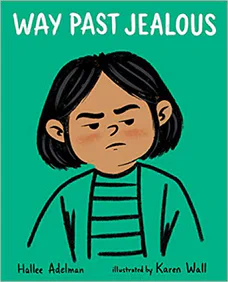Way Past Jealous
Written by Hallee Adelman
Illustrated by Karen Wall
32 pages
•
Published 2021 (Albert Whitman & Company)

Recommended Age Range: Kindergarten through 2nd grade.
Publisher's Summary:
Yaz is jealous. Way past jealous. Yaz loves to draw, but no one ever notices her pictures. Everyone loves Debby’s drawings, and one even got put up on the classroom wall with a star on it. Now Yaz’s jealousy is making her think ugly things, and even act mean! How can she get past jealous?

Dr. Annie's Takeaways
Recommended for: This book is a great read for a child who is feeling jealous of a peer/sibling’s accomplishments or attention and who has found themselves subsequently acting in ways that they aren’t proud of. It validates the feeling of jealousy and gently encourages a child to consider their values (e.g., friendship) and to act in ways that align with these values. It also includes a nice modeled apology at the end.
Would a child like it? Kids often feel ashamed of the feeling of jealousy. This book does a nice job destigmatizing the feeling and providing a path toward resolution, which will provide many children with relief.
Evidence-Based Practices:
Emotional Literacy
Tone: Heartfelt, authentic
Story Quality: This story puts words to an important feeling (jealousy). It successfully destigmatizes the feeling while also showing how it can have negative consequences if a child doesn’t manage it well. Yaz is relatably imperfect, and she shows a lot of growth over the story.
Illustrations: Warm, expressive illustrations with lots of contrasting colors.
Representation: Yaz is a girl with brown skin and straight black hair (she is perhaps Middle Eastern based on her name), and she has a father who also has brown skin and straight, black hair. Her best friend Debby is a Black girl. The kids in Yaz and Debby’s class are diverse and include cameos from the characters in Way Past Mad
. Their teacher is a White woman.
Psychological Practices: This story helps children to recognize and label the feeling of jealousy and to recognize how it can get in the way of their values and friendships. It also models a nice apology. Yaz is jealous of the attention her friend Debby is getting for her dog-drawing skills. She fantasizes about Debby’s picture torn up on the floor, ignores her friend and “storm[s] past her,” and finally steals her picture off of the classroom Stars of the Week board. When she realizes how much this hurt her friend, she doesn’t “feel so good” and she apologizes to Debby (“I swallowed hard and said, ‘I’m sorry. I was jealous of you’”). Debby doesn’t immediately forgive her, which is understandable and realistic. At home, Yaz talks to her dad about what happened, and he is non-judgmental and asks, “What are you going to do now?” (which I consider one of the golden parenting questions). Yaz realizes that more than anything else, she cares about her friendship with Debby and makes the decision to act in line with this value. The next day, she apologizes for hurting Debby and gives her a drawing of the two of them. Debby forgives her, and they have fun drawing together again.
Concerns: The book describes Yaz’s jealousy as “the kind of jealous that makes you feel bad, think ugly, and act mean.” This is a decent description of jealousy, but I’m always sensitive to thoughts being labeled in critical ways like “ugly.” We don’t have a ton of control over the thoughts that pop into our head, and I would never want a child to feel ashamed of the thoughts they have when they are having a hard time. An alternative way to describe these thoughts might be something like “think things you don’t mean.”
